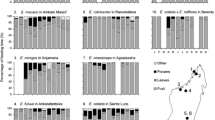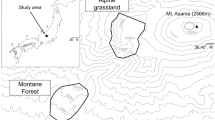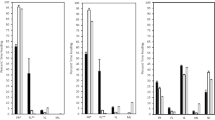Abstract
The introduction of Eulemur fulvus in 1975 into the Berenty Reserve and their recent attainment of population densities comparable to those of Lemur catta led us to analyze food partitioning among the 3 large prosimian species in the gallery forest. We assessed the diets of ring-tailed lemurs (Lemur catta), brown lemurs (Eulemur fulvus) and sifakas (Propithecus verreauxi) from food intake measurements during 3 successive short-term studies. All species exhibited marked seasonal changes in their major food categories. Dietary overlap was very high between ring-tailed lemurs and brown lemurs during 2 of 3 seasons, including the middle of the dry season. During the latter period, Eulemur appeared to compensate for a low quality diet by increasing the amount of food eaten. In contrast, Lemur fed on lower amounts of food and seemed more efficient at coping with fibrous plant materials. There is low dietary overlap of Lemur catta and Eulemur fulvus versus Propithecus, which exhibit by far the highest dietary diversity of the 3 species. We discuss sustainable coexistence among them, based on respective dietary adaptations and potential for dietary flexibility.
Similar content being viewed by others
References
Altmann, J. (1974). Observational study of behavior: Sampling methods. Behaviour 49: 227-267.
Birkinshaw, C. R. (1999). The importance of the black lemur (Eulemur macaco) for seed dispersal in Lokobe forest, Nosy Be. In Rakotosamimanana, B., Rasamimanana, H., Ganzhorn, J. U., and Goodman, S. J. (Eds.), New Directions in Lemur Studies, Kluwer Academic/Plenum Publishers, New York, pp. 189-199.
Campbell, J. L., Eisemann, J. H., Williams, C. V., and Glenn, K. M. (2000). Description of the gastrointestinal tract of five lemur species: Propithecus tattersalli, Propithecus verreauxi coquereli, Varecia variegata, Hapalemur griseus, and Lemur catta. Am. J. Primatol. 52: 133-142.
Charles-Dominique, P., and Hladik, C. M. (1971). Le lépilemur du sud de Madagascar: écologie, alimentation et vie sociale. Rev. Ecol. (Terre Vie) 25: 3-66.
Ganzhorn, J. U. (1988). Food partitioning among Malagasy primates. OEcol. 75: 436-450.
Gaulin, S. J. C., and Gaulin, C. K. (1982). Behavioral ecology of Alouatta seniculus in Andean cloud forest. Int. J. Primatol. 3: 1-32.
Gould, L., Sussman, R. W., and Sauther, M. L. (1999). Natural disasters and primate populations: The effect of a 2-year drought on a naturally occurring population of Ring-Tailed Lemurs (Lemur catta) in Southwestern Madagascar. Int. J. Primatol. 20: 69-84.
Hladik, C., Pinte, M., and Simmen, B. (1998). Les densités de population des Prosimiens nocturnes du sud de Madagascar varient-elles à long terme dans les réserves forestières accessibles au public? Rev. Ecol. (Terre Vie) 53: 181-185.
Hladik, C. M. (1977). A comparative study of the feeding strategies of two sympatric species of leaf monkeys: Presbytis senex and Presbytis entellus. In Clutton-Brock, T. H. (ed.), Primate Ecology: Studies of Feeding and Ranging Behaviour in Lemurs, Monkeys and Apes, Academic Press, London, pp. 323-353.
Hladik, C. M., Hladik, A., Bousset, J., Valdebouze, P., Viroben, G., and Delort-Laval, J. (1971). Le régime alimentaire des Primates de l'ile de Barro Colorado (Panama). Folia Primatol. 16: 85-122.
Jolly, A. (1966). Lemur Behavior. A Madagascar Field Study, University of Chicago Press, Chicago.
Jolly, A. (1972). Troop continuity and troop spacing in Propithecus verreauxi and Lemur catta at Berenty (Madagascar). Folia Primatol. 17: 335-362.
Jolly, A., Caless, S., Cavigelli, S., Gould, L., Pereira, M. E., Pitts, A., Pride, R. E., Rabenandrasana, H. D., Walker, J. D., and Zafison, T. (2000). Infant killing, wounding and predation in Eulemur and Lemur. Int. J. Primatol. 21: 21-40.
Jolly, A., Dobson, A., Rasamimanana, H., Walker, J., O'Connor, S., Solberg, M., and Perel, V. (2002). Demography of Lemur catta at Berenty Reserve, Madagascar: Effects of troop size, habitat and rainfall. Int. J. Primatol. 23: 327-353.
Jolly, A., Oliver, W. L. R., and O'Connor, S. M. (1982). Population and troop ranges of Lemur catta and Lemur fulvus at Berenty, Madagascar: 1980 Census. Folia primatol. 39: 115-123.
Jolly, A., and Pride, E. (1999). Troop histories and range inertia of Lemur catta at Berenty, Madagascar: A 33-year perspective. Int. J. Primatol. 20: 359-373.
Jolly, A., Rasamimanana, H. R., Kinnaird, M. F., O'Brien, T. G., Crowley, H. M., Harcourt, C. S., Gardner, S., and Davidson, J. M. (1993). Territoriality in Lemur catta groups during the birth season at Berenty, Madagascar. In Kappeler, P. M., and Ganzhorn, J. U. (Eds.), Lemur Social Systems and Their Ecological Basis, Plenum, New York, pp. 85-109.
Martin, R. D. (2000). Origins, diversity and relationships of lemurs. Int. J. Primatol. 21: 1021-1048.
Mittermeier, R. A., and van Roosmalen, M. G. M. (1981). Preliminary observations on habitat utilization and diet in eight Surinam monkeys. Folia Primatol. 36: 1-39.
O'Connor, S. (1988). Une revue des différences écologiques entre deux forêts galeries, une protégée et une dégradée, au centre sud de Madagascar. In Rakotovao, L., Barre, V., and Sayer, J. (Eds.), L'équilibre des écosystèmes forestiers à Madagascar, Actes d'un séminaire international, UICN, Gland, pp. 216-227.
Oates, J. F., Waterman, P. G., and Choo, G. M. (1980). Food selection by the south Indian leaf monkey, Presbytis johnii, in relation to leaf chemistry. Oecol. 45: 45-56.
Overdorff, D. J. (1993). Similarities, differences, and seasonal patterns in the diets of Eulemur rubriventer and Eulemur fulvus rufus in the Ranomafana National Park, Madagascar. Int. J. Primatol. 14: 721-753.
Overdorff, D. J., and Rasmussen, M. A. (1995). Determinants of nighttime activity in “diurnal” lemurid primates. In Alterman, L., Doyle, G. A., and Izard, M. K. (Eds.), Creatures of the Dark: The Nocturnal Prosimians, Plenum, New York, pp. 61-74.
Pereira, M. E. (1993). Seasonal adjustment of growth rate and adult body weight in ringtailed lemurs. In Kappeler, P. M., and Ganzhorn, J. U. (Eds.), Lemur Social Systems and Their Ecological Basis, Plenum, New York, pp. 205-221.
Pereira, M. E., Strohecker, R. A., Cavigelli, S. A., Hughes, C. L., and Pearson, D. D. (1999). Metabolic strategy and social behavior in Lemuridae. In Rakotosamimanana, B., Rasamimanana, H., Ganzhorn, J. U., and Goodman, S. J. (Eds.), New Directions in Lemur Studies, Kluwer Academic/Plenum Publishers, New York, pp. 93-118.
Pianka, E. R. (1973). The structure of lizard communities. Ann. Rev. Ecol. Syst. 4: 53-74.
Rasamimanana, H. R., and Rafidinarivo, E. (1993). Feeding behavior of Lemur catta females in relation to their physiological state. In Kappeler, P. M., and Ganzhorn, J. U. (Eds.), Lemur Social Systems and Their Ecological Basis, Plenum, New York, pp. 123-133.
Richard, A. (1978). Variability in the feeding behavior of a Malagasy prosimian, Propithecus verreauxi: Lemuriformes. In Montgomery, G. G. (ed.), The Ecology of Arboreal Folivores, Smithsonian Institution Press, Washington, DC, pp. 519-533.
Richard, A. F., Dewar, R. E., Schwartz, M., and Ratsirarson, J. (2000). Mass change, environmental variability and female fertility in wild Propithecus verreauxi. J. Hum. Evol. 39: 381-391.
Sauther, M. L. (1998). Interplay of phenology and reproduction in ring-tailed lemurs: Implications for ring-tailed lemur conservation. Folia Primatol. 69(Suppl. 1): 309-320.
Sauther, M. L., Sussman, R. W., and Gould, L. (1999). The socio-ecology of the Ring-Tailed Lemur: Thirty-five years of research. Evol. Anthropol. 8(4): 120-132.
Simmen, B., Hladik, A., Ramasiarisoa, P. L., Iaconelli, S., and Hladik, C. M. (1999). Taste discrimination in lemurs and other primates, and the relationships to distribution of plant allelochemicals in different habitats of Madagascar. In Rakotosamimanana, B., Rasamimanana, H., Ganzhorn, J. U., and Goodman, S. J. (Eds.), New Directions in Lemur Studies, Kluwer Academic/Plenum, New York, pp. 201-219.
Smith, R. J., and Jungers, W. L. (1997). Body mass in comparative primatology. J. Hum. Evol. 32: 523-559.
Sokal, R. R., and Rohlf, F. J. (1995). Biometry, Freeman, New York.
Sterling, E. (1993). Patterns of range use and social organization in aye-ayes (Daubentonia madagascariensis) on Nosy Mangabe. In Kappeler, P. M., and Ganzhorn, J. U. (Eds.), Lemur Social Systems and Their Ecological Basis, Plenum, New York, pp. 1-10.
Struhsaker, T. T. (1978). Food habits of five monkey species in the Kibale forest, Uganda. In Chivers, D. J., and Herbert, J. (Eds.), Recent Advances in Primatology, Vol. 1, Academic Press, London, pp. 225-248.
Sussman, R. (1974). Ecological distinctions in sympatric species of Lemur. In Martin, R. D., Doyle, G. A., and Walker, A. C. (Eds.), Prosimian Biology, Duckworth, London, pp. 75-108.
Tarnaud, L. (2002). L'ontogénèse du comportement alimentaire du primate Eulemur fulvus en forêt sèche (Mayotte, archipel des Comores) en relation avec le lien mère-jeune et la disponibilité des ressources alimentaires, Ph.D. Dissertation, University of Paris, Paris.
Tattersall, I. (1977). Ecology and behavior of Lemur fulvus mayottensis (Primates, Lemuriformes). Anthrop. Papers Am. Mus. Nat. Hist. 54: 421-482.
Tattersall, I. (1979). Patterns of activity in the Mayotte lemur. J. Mammal. 60: 314-323.
Terborgh, J. (1983). Five New World Primates. A Study in Comparative Ecology, Princeton University Press, Princeton, NJ.
Vasey, N. (2000). Niche separation in Varecia variegata rubra and Eulemur fulvus albifrons: I. Interspecific patterns. Am. J. Physic. Anthropol. 112: 411-431.
Yamashita, N. (2002). Diets of two sympatric lemur species in different microhabitats in Beza Mahafaly Special Reserve, Madagascar. Int. J. Primatol. 23: 1025-1051.
Author information
Authors and Affiliations
Corresponding author
Rights and permissions
About this article
Cite this article
Simmen, B., Hladik, A. & Ramasiarisoa, P. Food Intake and Dietary Overlap in Native Lemur catta and Propithecus verreauxi and Introduced Eulemur fulvus at Berenty, Southern Madagascar. International Journal of Primatology 24, 949–968 (2003). https://doi.org/10.1023/A:1026366309980
Issue Date:
DOI: https://doi.org/10.1023/A:1026366309980




